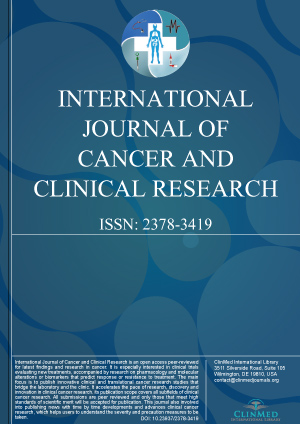Open Access DOI:10.23937/2378-3419/2/1/1013
Gene-Specific Promoter Methylation Status in Hormone-Receptor-Positive Breast Cancer Associates with Postmenopausal Body Size and Recreational Physical Activity
Lauren E. McCullough, Jia Chen, Alexandra J. White, Xinran Xu, Yoon Hee Cho, Patrick T. Bradshaw, Sybil M. Eng, Susan L. Teitelbaum, Mary Beth Terry, Gail Garbowski, Alfred I. Neugut, Hanina Hibshoosh, Regina M. Santella, Marilie D. Gammon
Article Type: Original Article | First Published: February 09, 2015
Introduction: Breast cancer, the leading cancer diagnosis among American women, is positively associated with postmenopausal obesity and little or no recreational physical activity (RPA). However, the underlying mechanisms of these associations remain unresolved. Aberrant changes in DNA methylation may represent an early event in carcinogenesis, but few studies have investigated associations between obesity/RPA and gene methylation, particularly in postmenopausal breast tumors where these lifest...
Open Access DOI:10.23937/2378-3419/2/1/1012
Phase I Clinical Study of Survivin-Derived Peptide Vaccine for Patients with Advanced Gastrointestinal Cancers
Fukino Satomi, Hiroaki Shima, Toru Mizuguchi, Toshihiko Torigoe, Goro Kutomi, Yasutoshi Kimura, Yoshihiko Hirohashi, Yasuaki Tamura, Tomohide Tsukahara, Takayuki Kanaseki, Akari Takahashi, Hiroko Asanuma, Yoichi M. Ito, Hiroshi Hayashi, Osamu Sugita, Noriyuki Sato and Koichi Hirata
Article Type: Original Article | First Published: February 04, 2015
Survivin is a member of the Inhibitor of Apoptosis Protein (IAP) family. It is expressed in fetal tissues but not in normal adult tissues. Since Survivin is over expressed in various types of tumor tissues as well as tumor cell lines, it is considered to be suitable as a target antigen for cancer vaccine therapy. We identified an HLA-A24-restricted antigenic peptide, SVN-2B (AYACNTSTL), derived from a splicing variant of Survivin-2B. In the present study, we carried out a phase I clinical study ...
Open Access DOI:10.23937/2378-3419/2/1/1011
Primitive Fallopian Tube Carcinosarcoma: Three Cases with Immunohistochemical Profiling
Mira Akiki, Fereshteh Farkhondeh, Virginie Fourchotte and Xavier Sastre-Garau
Article Type: Case Report | First Published: January 22, 2015
Most carcinosarcoma, formerly designed as Malignant Mixed Mullerian Tumors are found in the uterus or the ovary, but rarely in the fallopian tube. The histogenesis of this type of tumor and its place regarding serous or poorly differentiated carcinoma are discussed. We document here three typical cases primarily developed in the fallopian tube. The patients were 69, 70 and 82 years old. They all presented with abdominal pain and large unilateral adnexal mass apparently confined to the ovary. Bil...
Open Access DOI:10.23937/2378-3419/2/1/1010
Smac13-Tat Fusion Peptide Induces Cell Death and Sensitizes HeLa Cells to Chemotherapeutic Drugs
Yoshinori Mano, Toshihiko Torigoe, Hiroko Asanuma, Yoshihiko Hirohashi and Noriyuki Sato
Article Type: Original Article | First Published: January 19, 2015
Background: The inhibitor of apoptosis proteins (IAPs) are overexpressed in a variety of cancer cells and play an important role in the inhibition of caspases, thereby suppressing programed cell death and leading to chemoresistance of cancer cells. However, the anti-apoptotic function of IAPs could be suppressed by Smac, the second mitochondria-derived activator of caspase through its direct interaction with IAPs. Smac can interact with IAPs through the N-terminal Ala-Val-Pro-Ile tetrapeptide do...
Open Access DOI:10.23937/2378-3419/2/1/1009
A Cross-Disciplinary Look at Shoulder Pain and Dysfunction after Treatment for Breast Cancer
Delva Shamley
Article Type: Opinion | First Published: January 15, 2015
Shoulder morbidity is a well-documented consequence of treatment for breast cancer. Despite less invasive surgery, a subset of breast cancer survivors present with decreased shoulder complex mobility, tightness, oedema, weakness, pain and numbness after treatment. Additional considerations are connective tissue changes such as scarring and Axillary Web Syndrome (cording), which are known contributory factors to arm dysfunction and pain after treatment. Patients experiencing shoulder and arm prob...

